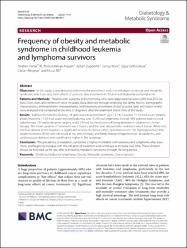| dc.contributor.author | Kartal, İbrahim | |
| dc.contributor.author | Alaçam, Abdurrahman | |
| dc.contributor.author | Dağdemir, Ayhan | |
| dc.contributor.author | Kara, Cengiz | |
| dc.contributor.author | Dinçer, Oğuz Salih | |
| dc.contributor.author | Albayrak, Canan | |
| dc.contributor.author | Elli, Murat | |
| dc.date.accessioned | 2022-02-03T08:08:23Z | |
| dc.date.available | 2022-02-03T08:08:23Z | |
| dc.date.issued | 2022 | en_US |
| dc.identifier.citation | Kartal, İ., Alaçam, A., Dağdemir, A., Kara, C., Dinçer, O. S., Albayrak, C. ve Elli, M. (2022). Frequency of obesity and metabolic syndrome in childhood leukemia and lymphoma survivors. Diabetology and Metabolic Syndrome, 14(1). https://dx.doi.org/10.1186/s13098-022-00790-4 | en_US |
| dc.identifier.issn | 1758-5996 | |
| dc.identifier.uri | https://dx.doi.org/10.1186/s13098-022-00790-4 | |
| dc.identifier.uri | https://hdl.handle.net/20.500.12511/8955 | |
| dc.description.abstract | Objectives In this study, it was aimed to determine the prevalence and clinical features of obesity and metabolic syndrome, which are long-term effects of survivors after treatment in children with leukemia and lymphoma. Patients and Methods Patients with leukemia and lymphoma, who were diagnosed between 2000 and 2012 (at least 2 two years after remission) were included. Data obtained through reviewing the family history, demographic characteristics, anthropometric measurements, and laboratory parameters (blood glucose, lipid, and insulin levels) were analyzed and compared at the time of diagnosis, after the treatment and at time of the study. Results Eighty nine patients (45 boys, 44 girls) were included (mean age: 14.7 +/- 4.3 years): 77.5% had acute lymphoblastic leukemia, 11.2% had acute myeloid leukemia, and 11.2% had lymphoma. Overall, 46% patients had received radiotherapy, 7% had undergone surgery, and 2.2% had received stem cell transplantation in addition to chemotherapy. The mean duration of treatment was 2.4 years, and the time elapsed after treatment was 4.9 years. While only one had obesity at the diagnosis, a significant increase in obesity (20%), hypertension (15.7%), hyperglycemia (15%), insulin resistance (35%) were observed at the time of study, and family history of hypertension, dyslipidemia, and cardiovascular diseases were significantly higher in this subgroup. Conclusion The prevalence of metabolic syndorme is higher in children with leukemia and lymphoma after treatment, and begins to increase with the initiation of treatment and continues to increase over time. These children should be followed-up for late-effects including metabolic syndrome through life-long period. | en_US |
| dc.language.iso | eng | en_US |
| dc.publisher | BioMed Central Ltd | en_US |
| dc.rights | info:eu-repo/semantics/openAccess | en_US |
| dc.rights | Attribution 4.0 International | * |
| dc.rights.uri | https://creativecommons.org/licenses/by/4.0/ | * |
| dc.subject | Childhood Leukemia-Lymphoma | en_US |
| dc.subject | Obesity | en_US |
| dc.subject | Metabolic Syndrome | en_US |
| dc.subject | Cancer Survivor | en_US |
| dc.title | Frequency of obesity and metabolic syndrome in childhood leukemia and lymphoma survivors | en_US |
| dc.type | article | en_US |
| dc.relation.ispartof | Diabetology and Metabolic Syndrome | en_US |
| dc.department | İstanbul Medipol Üniversitesi, Tıp Fakültesi, Dahili Tıp Bilimleri Bölümü, Çocuk Sağlığı ve Hastalıkları Ana Bilim Dalı | en_US |
| dc.authorid | 0000-0002-0476-5452 | en_US |
| dc.identifier.volume | 14 | en_US |
| dc.identifier.issue | 1 | en_US |
| dc.relation.publicationcategory | Makale - Uluslararası Hakemli Dergi - Kurum Öğretim Elemanı | en_US |
| dc.identifier.doi | 10.1186/s13098-022-00790-4 | en_US |
| dc.identifier.wosquality | Q3 | en_US |
| dc.identifier.scopusquality | Q1 | en_US |



















